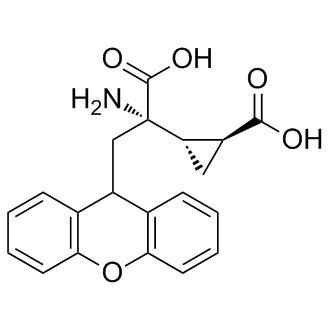| DC47572 |
PHCCC(4Me)
|
PHCCC(4Me) (THCCC), a PHCCC analog, is a dual mGluR2 (IC50 of 1.5 μM) negative allosteric modulator and mGluR3 (EC50 of 8.9 μM) positive allosteric modulator. |
| DC46849 |
L-AP3
|
L-AP3, metabotropic glutamate receptor (mGluR) antagonist, inhibits D-phosphoserine and L-phosphoserine with IC50s of 368 μM and 2087 μM, respectively. |
| DC46848 |
UPF-523
|
UPF-523 (AIDA), a rigid (carboxyphenyl) glycine derivative, is a relatively potent and selective antagonist of group I metabotropic glutamate receptors (mGlu1a) with an IC50 of 214 μM. But UPF-523 has no effect on group II (mGlu2), group III (mGlu4) receptors or ionotropic glutamate receptors. UPF-523 has the potential for the research of the acute arthritis. |
| DC46345 |
(E/Z)-SIB-1893
|
(E/Z)-SIB-1893 is a racemic compound of (E)-SIB-1893 and (Z)-SIB-1893 isomers. (E)-SIB-1893 is a selective non-competitive metabotropic glutamate subtype 5 receptor (mGluR5) antagonist. |
| DC46287 |
HexylHIBO
|
HexylHIBO is a potent group I mGluR antagonist with Kbs of 140 and 110 μM at mGlu1a and mGlu5a receptors, respectively. HexylHIBO decreased sEPSC in rat. |
| DC46264 |
MGS0274
|
MGS0274, an ester-based lipophilic prodrug of a metabotropic glutamate (mGlu)2 and mGlu3 receptor agonist MGS0008, shows improved oral bioavailability. MGS0274 has the potential for the research of schizophrenia. |
| DC45308 |
LY367385 hydrochloride
|
LY367385 hydrochloride is a highly selective and potent mGluR1a antagonist. LY367385 hydrochloride has an IC50 of 8.8 μM for inhibits of quisqualate-induced phosphoinositide (PI) hydrolysis, compared with >100 μM for mGlu5a. LY367385 hydrochloride has neuroprotective, anticonvulsant and antiepileptic effects. |
| DC44959 |
VU0080241
|
VU0080241 is a positive allosteric modulator (PAM) of the metabotropic glutamate receptor subtype 4 (mGluR4), with an EC50 of 4.6 μM. |
| DC44958 |
(±)-LY367385
|
(±)-LY367385 is the racemate of LY367385. LY367385 is a highly potent and selective mGluR1a antagonist. LY367385 has an IC50 of 8.8 μM for inhibits of quisqualate-induced phosphoinositide (PI) hydrolysis, compared with > 100 μM for mGlu5a. |
| DC44957 |
JF-NP-26
|
JF-NP-26, an inactive photocaged derivative of raseglurant, is the first caged mGlu5 receptor negative allosteric modulator. Uncaging of JF-NP-26 is elicited with light pulses in the visible spectrum (405 nm). JF-NP-26 induces light-dependent analgesia in models of inflammatory and neuropathic pain in freely behaving animals. |






















